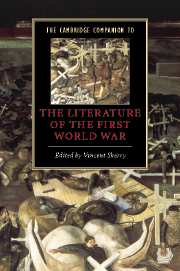Book contents
- Frontmatter
- Introduction
- Part I The Great War in British literary culture
- Part II The world war: Pan-European views, transatlantic prospects
- Part III Postwar engagements
- 10 Myths, memories, and monuments: reimagining the Great War
- 11 Interpreting the war
- 12 The Great War in twentieth-century cinema
- Guide to Further Reading
- Index
- Series List
12 - The Great War in twentieth-century cinema
from Part III - Postwar engagements
Published online by Cambridge University Press: 28 May 2006
- Frontmatter
- Introduction
- Part I The Great War in British literary culture
- Part II The world war: Pan-European views, transatlantic prospects
- Part III Postwar engagements
- 10 Myths, memories, and monuments: reimagining the Great War
- 11 Interpreting the war
- 12 The Great War in twentieth-century cinema
- Guide to Further Reading
- Index
- Series List
Summary
”Of all the arts,” Modris Eksteins writes, “the one that may best express the conflicts in the twentieth-century soul is film.” The years of World War I were those in which film was becoming increasingly accepted as a legitimate source of entertainment, as a serious art form, as a crucial medium for education, and as the most effective propaganda instrument. In one sense, the relationship between World War I and cinema is a matter of historical and temporal concurrence or coincidence; in another, modern war and film have a complex and profound interconnection, as twin technologies of modernity. World War I was, Paul Virilio has argued, not only “bloody conflict” but a pyrotechnic “lighting war,” a “continuous performance, all day and all night.”
The question of what defined “war films” during the years of the First World War is a complex one. In her study of US cinema and World War I, Leslie Midkiff DeBauche notes that film producers, distributors, exhibitors, and reviewers took up varying positions on the question of the role of popular culture in periods of national crisis, and were often divided between the view that films should provide escape from contemporary realities, with comedy tending to be favored as the proper film genre in wartime, and the conviction that it was the role of film to reflect historical immediacies.
- Type
- Chapter
- Information
- The Cambridge Companion to the Literature of the First World War , pp. 280 - 301Publisher: Cambridge University PressPrint publication year: 2005
- 2
- Cited by



